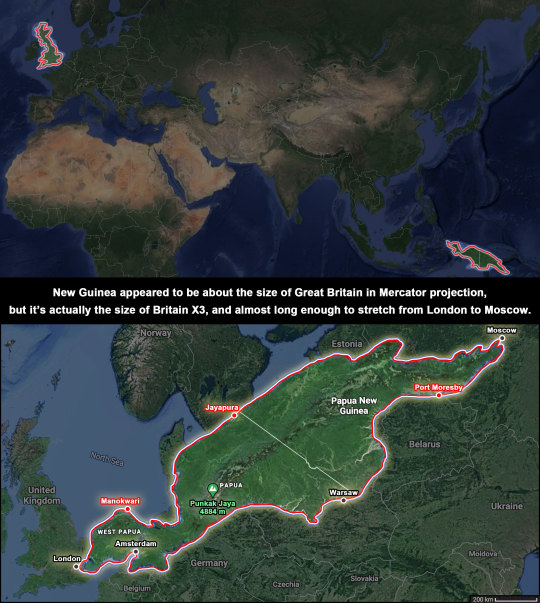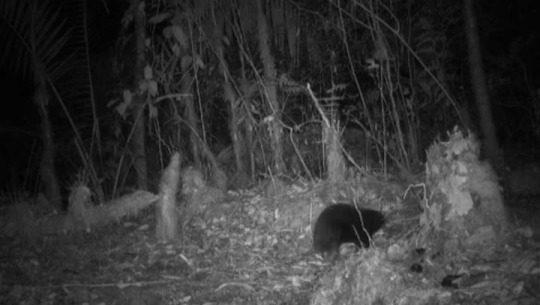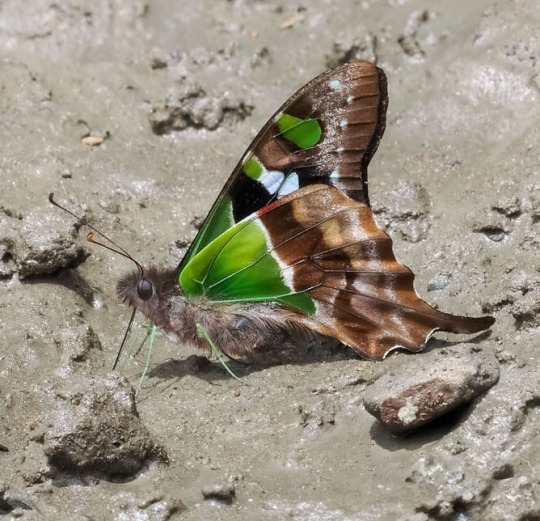#new guinea
Text


Dracula Parrot aka Pesquet’s Parrot (Psittrichas fulgidus), family Psittaculidae, order Psittaciformes, endemic to New Guinea
photographs by Peter Tan & Greg Hume
847 notes
·
View notes
Photo

The true size of New Guinea
We all know Greenland is oversized in Mercator projection, so I thought, what about the true size of the next largest island: New Guinea?
by BerryBlue_BlueBerry
1K notes
·
View notes
Video
‘Lost’ pigeon found after more than a century
A September expedition to Papua New Guinea confirmed via video the existence of the black-naped pheasant pigeon, a critically endangered species that has not been reported for 140 years.
“For much of the trip, it seemed like we had no chance of finding this bird,” said Jordan Boersma, co-leader of the expedition and a postdoctoral researcher at the Cornell Lab of Ornithology. “We were just two days away from the end of our time on Fergusson Island in Papua New Guinea when one of our remote cameras recorded the bird walking around and fanning its tail.”
The group captured the first-ever video and still photos of the bird, a large ground-dwelling species with a rust-colored back, a black head and body, and a bobbing pheasant-like tail. It may only exist far inland on Fergusson Island in hot, extremely rugged geothermal terrain laced with twisty rivers and dense with biting insects and leeches...
Read more: https://news.cornell.edu/stories/2022/11/lost-pigeon-found-after-more-century
5K notes
·
View notes
Text

Irving Penn, "Six New Guinea Mudmen," 1970,
Platinum-palladium print, mounted on aluminum, printed 1983,
Image: 13 ¼ x 13 ¼ in. (33.6 x 33.6 cm.)
Sheet: 22 7⁄8 x 20 in. (58.1 x 50.8 cm.)
Mount: 24 x 20 in. (60.9 x 50.8 cm.)
Sir Elton John Photography collection
#art#photography#black and white#vintage photography#still life photography#history#portrait#irving penn#new guinea#mudmen#elton john#1970
643 notes
·
View notes
Text

#blk&wht photography#vintage photography#vintage military#American soldiers Admiralty Islands off New Guinea (1944)#Admiralty Islands#new guinea#1944
179 notes
·
View notes
Text
Wonderful news from the Cyclops Mountains of West Papua today with the rediscovery of Attenborough's long-beaked echidna (Zaglossus attenboroughi)!

(Image credit: Expedition Cyclops)
Previously known a single specimen collected in 1961, Attenborough's long-beaked echidna has long been one of the world's most elusive mammals. Recognised as a distinct species in 1998, an expedition to the Cyclops Mountains in 2007 failed to observe the echidna but found evidence of recent diggings and foraging activity which, alongside local knowledge, implied that the species still survived in those remote mountain forests.
Finally, just a few months ago, a new expedition into its remote mountain home by Expedition Cyclops caught the first ever footage of Attenborough's long-beaked echidna in the wild, which is also the first time it has been seen by scientists in over 60 years. In a remarkable stroke of luck, the echidna was captured on the last of over 80 camera traps on the final day of the trip!
Attenborough's long-beaked echidna is the most distinctive of the three species of long-beaked echidna thanks to its smaller size, shorter, straighter beak and reddish-brown fur. Its habits are virtually unknown, but its differently shaped beak may suggest that it differs in diet and feeding habits from the other two long-beaked echidna species. It appears to be endemic to the highest elevations of the Cyclops Mountains, which are steep, extremely rainy and treacherous to explore, hence why it remained hidden for so long.

(Image credit: Expedition Cyclops)
There are only five species of monotreme alive today, the sole living custodians of a lineage stretching back some 200 million years, and this makes each species extraordinarily valuable. Unfortunately, all three species of long-beaked echidna are threatened with extinction, with Attenborough's long-beaked echidna being classed as critically endangered. Losing any species is a tragedy, but for a group as small and precious as monotremes, any extinction would be especially disastrous.
Alongside the rediscovery of the echidna, Expedition Cyclops also made the first record of Mayr's honeyeater (Ptiloprora mayri) in 16 years and discovered dozens of new species of insects, arachnids, shrimp and frogs. Their work documenting the hidden biodiversity of the Cyclops Mountains is ongoing, so if you'd like to follow and support the expedition make sure to visit their website!
https://www.expeditioncyclops.org/
#oceania#papua#west papua#new guinea#wildlife#mammal#mammals#monotreme#monotremes#echidna#echidnas#animal facts#animal news#mammalogy#natural history#my stuff
288 notes
·
View notes
Link
Research in the jungle of New Guinea reveals two species of birds that carry a powerful neurotoxin.
“These birds contain a neurotoxin that they can both tolerate and store in their feathers,” says Knud Jønsson of the Natural History Museum of Denmark, who worked with Kasun Bodawatta of the University of Copenhagan.
The bird species have each developed the ability to consume toxic food and turn that into a poison of their own.
The species in question are the regent whistler (Pachycephala schlegelii), a species that belongs to a family of birds with a wide distribution and easily recognizable song well known across the Indo-Pacific region, and the rufous-naped bellbird (Aleadryas rufinucha).
“We were really surprised to find these birds to be poisonous as no new poisonous bird species has been discovered in over two decades. Particularly, because these two bird species are so common in this part of the world,” says Jønsson. The findings appear in the journal Molecular Ecology.
Continue Reading
906 notes
·
View notes
Photo

Irving Penn. Three Asaro Mud Men, New Guinea. 1970
Follow my new AI-related project «Collective memories»
#BW#Black and White#Preto e Branco#Noir et Blanc#黒と白#Schwarzweiß#retro#vintage#Irving Penn#Asaro Mud Men#New Guinea#1970#1970s#70s#people#pessoas#personnes#Menschen#Personen#人#ピープル
198 notes
·
View notes
Text
Great news for monotreme lovers!!!

The Sir David Attenborough's Long-Beaked Echidna (Zaglossus attenboroughi) has been sighted for the first time since 1961!
Also known as the Cyclops Long-Beaked Echidna, this nocturnal critter was first described by Western scientists in 1961 during the Dutch colonial era of what was then known as Dutch New Guinea. It was only described from a fragmentary preserved specimen (pictured below) and was of course named after the famous naturalist Sir David Attenborough. However, I do want to point out that, as is the case with many newly discovered species, it was known to the native people of this region way before this and was traditionally hunted for both food and for ceremonial peace offerings. However, according to my research since the species was classified as Critically Endangered, the native villagers were very enthusiastic about its conservation and agreed not to hunt them in order to help preserve the species.

Z. attenboroughi is native to the Cyclops Mountain Chain in northern Indonesian New Guinea and feeds mostly on worms, ants, termites, and other invertebrates by using their long beaks to forage through the soil and creating distinct “nose pokes”. For a long time, these “nose pokes” were the only sign scientists had that this species hadn’t gone extinct. The last unconfirmed sighting by locals was in 2005, though some tracks and burrows that were thought to belong to the species were discovered in 2007.
Now, over 60 years after it was initially described, an expedition of scientists from Oxford University to the Cyclops Mountains has resulted in this elusive monotreme being videotaped by a game trail camera.


Photo credit: Cyclops Expedition
Attenborough’s Long-Beaked Echidna might somewhat resemble hedgehogs in appearance and behavior, however, they are one of only five species of egg-laying mammals known as monotremes! The other four species are the Short-Beaked Echidna, Western Long-Beaked Echidna, Eastern Long-Beaked Echidna, and the Platypus. The Attenborough’s Long-Beaked Echidna is the smallest species of Echidna and is apparently more closely related to the Short-Beaked Echidna than it is to the other two species of Long-Beakeds. It also possesses a more reddish coloration. All species of monotremes are known for, as I mentioned before, laying eggs instead of giving live birth like placental mammals and marsupials do. Monotremes also lack nipples and instead produce milk for their young out of modified sweat glands like how the early ancestors of all mammals did. Male Platypi/Platypuses (both terms are correct) and Echidnas also have ankle spurs which are highly venomous in the case of the Platypus, but Echidnas seem to have lost their venom and instead use them to help dig. Apparently, they also seasonally secrete a creamy substance their spurs but this, while kinda gross, is harmless.
While the rediscovery of this species is super exciting, we mustn’t forget that Attenborough’s Long-Beaked Echidna is considered Critically Endangered and is still at risk of extinction. Habitat loss and poaching seem to be the biggest threats to this species and many other unique creatures endemic to Oceania.
#monotreme#echidna#new discoveries#critically endangered#science#infodump#animals#endangered species#new guinea#animal news
178 notes
·
View notes
Text

F6F Hellcats warming up on the deck of USS Lexington CV-16, en route near New Guinea, early April 1944
VIDEO ➤➤ https://youtu.be/15HLOfODKGo
#youtube#aircraft#airplane#aviation#ww2#wwii#dronescapes#military#documentary#aircraft carrier#ww2 pilot#ww2 aircraft#ww2 history#uss lexington#f6f#hellcat#F6F Hellcat#grumman#new guinea#pacific war#world war 2#world war two#world war ii#plane
176 notes
·
View notes
Text


Purple-spotted Swallowtail (Graphium weiskei), family Papilionidae, Papua New Guinea
photograph by Gan CW
#swallowtail#graphium#papilionidae#lepidoptera#butterfly#entomology#insect#new guinea#animals#nature
5K notes
·
View notes
Text

Minimal elephant logo - lineart style ♡
Get your unique & creative logo for your business to emphasize your visual identity!!
#elephant#africa#senegal#new guinea#madagascar#monologo#monoline#lineart#logo#illustration#artists on tumblr#clothing#etsy#consulting#minimalism
25 notes
·
View notes
Photo

Australia and New Guinea recombine regularly, and when they do they form a continent known as Sahul, most recently around 8,000 years ago.
by @theatlaspro
710 notes
·
View notes
Photo

Five new species of the Pelodryadid genus Litoria from the southern versant of Papua New Guinea’s Central Cordillera, with observations on the diversification of reproductive strategies in Melanesian treefrogs
Stephen J Richards, Stephen C. Donnellan, Paul M. Oliver
ABSTRACT
New Guinea has the most diverse insular frog fauna in the world, and rates of species discovery and description have increased rapidly in the last two decades. Pelodryadid treefrogs are the second most diverse family of anurans on the island but their taxonomy, relationships, and especially ecology remain poorly documented.
Based on differences in morphology, advertisement calls (where available) and phylogenetic analyses of a 787 base pair alignment from the mitochondrial ND4 gene and flanking tRNA, we describe five new species of small treefrogs from hill and lower montane forests in the high rainfall belt that straddles the southern versant of Papua New Guinea’s Central Cordillera.
Three of these species are known only from forest growing on karst substrates, adding to the growing number of herpetofauna species currently known only from the extensive karst habitats of Papua New Guinea’s South-fold Mountains.
We also describe the arboreal breeding strategies of two of the new species, and report obligate treehole (phytotelm) breeding in New Guinean frogs for the first time. The new phytotelm–breeding species has juveniles with colour and patterning that closely resemble bird droppings, suggesting defensive mimicry or masquerade.
A preliminary phylogeny suggests that arboreal-breeding frogs do not form a monophyletic group and that arboreal breeding has evolved multiple times within the New Guinean pelodryadid radiation. A further striking feature of the phylogeny is poor support for most basal nodes in the most diverse radiation of Melanesian Pelodryadidae, suggesting rapid ecological diversification and speciation, potentially following colonisation from Australia and/or mountain uplift.
These new taxa and observations highlight previously unrecognised ecological and reproductive diversity in the Melanesian Pelodryadidae.
Read more here:
https://mapress.com/zt/article/view/zootaxa.5263.2.1
161 notes
·
View notes
Text

A camouflaged Japanese plane is destroyed during a low-level attack in Papua New Guinea possibly around 1942/43 CREDIT : Royston Leonard
#world war two#ww2#worldwar2photos#history#1940s#wwii#ww2 history#wwii era#world war 2#ww2history#papua new guinea#new guinea#war in the pacific#pacific ocean#pacific#1942#1943
69 notes
·
View notes
Text
In the Mysterious Papua walk in aviary, a Nicobar Pigeon or dove was nesting right next to the walkway just out of reach to the human hand. A few of its feathery friends are pecking at plates of what look like fresh salad.




#Bird Paradise#Singapore#Mandai#Mandai Wildlife Reserve#Mysterious Papua#New Guinea#Walk In Aviary#Nicobar Pigeon#Dove#Nest#Feeding Station#Colourful#Birds#Buffetlicious
23 notes
·
View notes